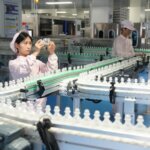China’s Top Engineering Academy Embraces Private Sector Talent
In a landmark move that signals a profound shift in China’s approach to scientific and technological advancement, the Chinese Academy of Engineering (CAE) has, for the first time, opened its doors wide to private sector innovators. This year, a record number of private-sector executives and chief scientists have been shortlisted for the prestigious title of academician—China’s highest honor for engineers and technologists. The development marks a turning point in the country’s efforts to harness the full innovative potential of its booming private economy.
- China’s Top Engineering Academy Embraces Private Sector Talent
- Why Is the CAE Recruiting from the Private Sector?
- What Does This Mean for China’s Innovation Ecosystem?
- Legal and Policy Support: Creating a Favorable Environment for Innovation
- China’s Global Talent Strategy: Attracting and Retaining Top Scientists
- Strategic Sectors: AI, Biotech, and Dual-Use Technologies
- Competition for Prestige: The CAE and China’s “Iron Rice Bowl” Culture
- Fostering a Culture of Innovation: Hacking Contests and Talent Pipelines
- Broader Implications: What’s Next for China’s Innovation Drive?
- In Summary
The CAE, often compared to the U.S. National Academy of Engineering, has traditionally drawn its members from universities, state-backed research institutes, and state-owned enterprises. However, the 2025 candidate list features 19 leaders from private enterprises, including Hu Guoping of AI powerhouse iFlyTek, Wu Kai of battery giant CATL, Lian Yubo of electric vehicle leader BYD, Jia Zhenhua of Yiling Pharmaceutical, and Xu Xun of genomics heavyweight BGI Group. The remaining candidates represent cutting-edge fields such as artificial intelligence, new energy, and biopharmaceuticals.
Why Is the CAE Recruiting from the Private Sector?
This unprecedented recruitment drive reflects China’s recognition that private companies are now at the forefront of technological innovation. According to the CAE’s 2025 guidelines, the academy aims to “prioritize experts from leading tech companies, particularly the private sector,” with about 30 percent of candidates coming from corporate research front lines. Of the 100 new seats available in this round—the largest intake in a decade—eight are reserved specifically for private sector leaders.
China’s private sector has become a vital engine of economic growth, contributing over 60 percent of GDP and 80 percent of urban employment. With more than 55 million registered private enterprises making up over 92 percent of all businesses in China, the sector’s influence is undeniable. Yet, until recently, the path to the nation’s highest scientific honors was largely closed to those outside the state system.
By opening the CAE to private innovators, China is not only acknowledging the sector’s scientific prowess but also sending a strong signal to entrepreneurs and researchers: private enterprise is now central to the country’s technological ambitions.
What Does This Mean for China’s Innovation Ecosystem?
China’s rapid ascent as a global innovator is no longer in question. The country leads or matches the West in sectors such as electric vehicles, batteries, and commercial nuclear power, and is making swift progress in robotics, biopharmaceuticals, chemicals, and artificial intelligence. This progress is driven by a combination of massive government investment, strategic industrial policies, and the growing capabilities of Chinese universities and companies.
On key innovation indicators—such as research and development (R&D) spending, patent filings, and scientific publications—China now rivals or surpasses the United States. The synergy between academia, industry, and government has created a formidable innovation ecosystem. The inclusion of private sector leaders in the CAE is expected to further accelerate this trend by fostering deeper collaboration and knowledge exchange across sectors.
Private Sector Leaders at the Cutting Edge
The private sector candidates shortlisted for CAE membership are not just business executives—they are chief scientists and principal researchers driving breakthroughs in their fields:
- Hu Guoping (iFlyTek): A pioneer in artificial intelligence and speech recognition technologies.
- Wu Kai (CATL): Instrumental in making China the world leader in battery technology for electric vehicles.
- Lian Yubo (BYD): At the forefront of automotive innovation and green energy solutions.
- Jia Zhenhua (Yiling Pharmaceutical): Leading advances in biopharmaceuticals and healthcare innovation.
- Xu Xun (BGI Group): A key figure in genomics and biotechnology, with global influence.
These individuals exemplify the new breed of Chinese scientist-entrepreneurs whose work is shaping the future of technology both in China and worldwide.
Legal and Policy Support: Creating a Favorable Environment for Innovation
The CAE’s recruitment shift is part of a broader policy push to empower the private sector. In recent years, Chinese lawmakers have advanced the country’s first law specifically dedicated to promoting and protecting private enterprise. The draft private economy promotion law, currently under deliberation, aims to dismantle market barriers, ensure fair competition, and foster innovation.
The law defines the private sector as a vital pillar of the socialist market economy and mandates equal access to all industries unless restricted by a negative list. It also strengthens intellectual property protections, streamlines regulatory processes, and encourages private firms to participate in national scientific and technological projects. Experts believe these measures will boost entrepreneurial confidence and stimulate long-term investment in innovation.
According to a China Daily report, the law supports the active participation of private entities in major national scientific research infrastructure and promotes collaboration across industry, academia, and research institutes. This legal backing is crucial for integrating private sector innovation into the national development strategy.
China’s Global Talent Strategy: Attracting and Retaining Top Scientists
China’s embrace of private sector innovators is also part of a broader strategy to attract and retain top scientific talent. In recent years, thousands of Chinese scientists have returned from the United States and other countries, drawn by generous funding, advanced research facilities, and prestigious positions. This “reverse brain drain” is reshaping global scientific leadership and boosting China’s competitiveness in fields such as artificial intelligence, biotechnology, and semiconductors.
Geopolitical tensions, restrictive U.S. visa policies, and concerns about racial profiling have contributed to this trend. Many Chinese scientists report feeling unsafe in the U.S. research environment, prompting them to seek opportunities at home or in other countries with more supportive policies. China’s investment in research infrastructure and its willingness to elevate private sector leaders to national prominence are powerful incentives for top talent to stay or return.
Strategic Sectors: AI, Biotech, and Dual-Use Technologies
The CAE’s new intake reflects China’s strategic focus on sectors with both economic and security significance. Artificial intelligence, biotechnology, and new energy are not only engines of economic growth but also have important military and dual-use applications. For example, genomics company BGI Group collaborates with the People’s Liberation Army on research projects, while AI and battery technologies are critical for both civilian and defense industries.
China’s approach to technological development is characterized by the integration of civilian and military sectors—a policy known as “military-civil fusion.” This enables the transfer of advanced technologies and data to the military, enhancing national security and military modernization. The legal framework, including the Biosecurity Law and Cybersecurity Law, ensures state control over sensitive data and mandates cooperation between companies and security agencies.
Global Implications and Security Concerns
China’s rapid progress in strategic sectors has raised concerns in the United States and allied countries about data security, intellectual property, and the potential for technological dependencies. U.S. government reports have highlighted the risks of China’s talent recruitment programs, which are designed to transfer knowledge and intellectual property from abroad. In response, the U.S. has imposed sanctions, export controls, and increased oversight of Chinese companies operating in sensitive areas.
Nevertheless, China’s innovation system continues to strengthen, and its model of integrating private sector talent into national scientific institutions is being closely watched by other countries. Some experts suggest that the U.S. and others could benefit from adopting similar approaches to foster collaboration between academia, industry, and government.
Competition for Prestige: The CAE and China’s “Iron Rice Bowl” Culture
The fierce competition for CAE membership mirrors the broader race for prestigious positions in China’s public sector. Millions of applicants vie each year for civil service jobs—known as “iron rice bowl” positions—offering stability and social status. The CAE’s selective recruitment process, with only 100 seats available for about 600 nominees, is equally competitive and highly coveted among scientists and engineers.
By opening the academy to private sector leaders, China is redefining what it means to achieve professional recognition and influence in the country’s innovation landscape. The move is expected to inspire more private sector researchers to pursue groundbreaking work and contribute to national priorities.
Fostering a Culture of Innovation: Hacking Contests and Talent Pipelines
China’s commitment to cultivating scientific talent extends beyond formal institutions. The country has developed the world’s most comprehensive ecosystem for capture-the-flag (CTF) hacking competitions, which serve as key platforms for identifying and nurturing cybersecurity talent. These contests, supported by both state and private actors, are used for recruitment into government agencies and critical industries, as well as for fostering collaboration between academia and the private sector.
Such initiatives highlight China’s holistic approach to talent development, integrating education, industry, and government to build a robust pipeline of innovators capable of driving technological progress and national security.
Broader Implications: What’s Next for China’s Innovation Drive?
The CAE’s embrace of private sector innovators is more than a symbolic gesture—it is a strategic move that could reshape the country’s innovation ecosystem for years to come. By recognizing and empowering private enterprise, China is positioning itself to lead in the next wave of technological transformation.
However, challenges remain. Despite policy reforms and legal protections, private enterprises still face barriers to market access, regulatory hurdles, and concerns about intellectual property rights. Effective implementation of new laws and continued support for private sector research will be critical to sustaining momentum.
Internationally, China’s rise as a technological powerhouse is prompting other countries to rethink their own innovation strategies. The integration of private sector talent into national academies, the cultivation of global scientific networks, and the balancing of security concerns with openness will be central issues in the evolving landscape of global science and technology leadership.
In Summary
- The Chinese Academy of Engineering is recruiting a record number of private sector leaders, marking a major shift in China’s innovation strategy.
- This move recognizes the scientific and technological capabilities of private enterprises and aims to foster deeper collaboration across sectors.
- Legal and policy reforms are creating a more favorable environment for private sector innovation, with new laws promoting fair competition and intellectual property protection.
- China’s global talent strategy is attracting top scientists, including those returning from the U.S., strengthening the country’s innovation ecosystem.
- Strategic sectors such as AI, biotechnology, and new energy are at the heart of China’s technological ambitions, with implications for both economic growth and national security.
- The CAE’s recruitment drive reflects broader trends in China’s approach to talent development, including the use of hacking contests and integrated talent pipelines.
- China’s model is being closely watched internationally, as countries seek to balance innovation, security, and global collaboration in the race for technological leadership.












